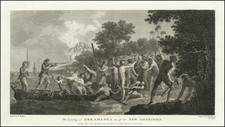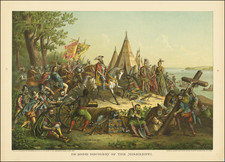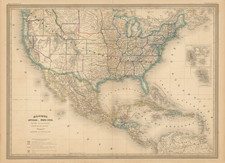Encampment of the Piekann Indians, a hand-colored aquatint by Swiss artist Karl Bodmer, presents an intimate and vibrant depiction of Native American life in the 19th century. Created after artwork made during Bodmer's expedition with Prince Maximilian of Wied to Fort McKenzie in August and September 1833, this image captures the Piekann Indians' camp, set against the backdrop of the fort (though not pictured) and made during a period of unprecedented contact with the traditionally hostile Blackfeet tribe.
Bodmer's sojourn at Fort McKenzie, established a year before by the American Fur Company, resulted in a detailed exploration of indigenous life, customs, and appearances. His visual documentation of the Blackfeet offers rare insights into a tribe known for their resistance to outsiders, highlighting the opening of trade routes and fostering diplomatic relations between the Blackfeet and the newly established colonial settlers. The aquatint also emphasizes the powerful role of the American Fur Company in facilitating these crucial cultural intersections.
The piece provides remarkable detail, from the meticulously illustrated figures of Piekann men, such as Natoië-Poochsen (Word of Life) and Kiäsax (Bear on the Left), to the visual replication of a war robe of an unnamed Piegan Blackfeet man. These depictions demonstrate Bodmer's respect and fascination for Native American cultures, as well as his talent for fine, accurate portraiture. Moreover, Bodmer's inclusion of Ho-Ta-Mä, a Ponca man met at Fort Pierre, alludes to the broader intertribal relations within the Native American landscape.
Encampment of the Piekann Indians also serves as a testament to Bodmer's artistic process. Preliminary drawings done during his stay at the fort later found their way into the final print. The tableau forms part of a larger body of work produced by Bodmer during his travels with Maximilian, which was displayed at the 1836 Paris Salon and remains critical to our understanding of Native American societies in the 19th century. Thus, through Bodmer's keen eye and skilled hand, the viewer is invited to step into a world often unseen, fostering a deeper understanding of indigenous cultures in a period of rapid colonial expansion.
State
Ruud's 1st of 2 states, lacking the date.









![[Early Montana Territory Shown Above Idaho] Johnson's New Military Map of the United States Forts, Military Posts & all the Military Divisions with Enlarged Plans of the Southern Harbors . . . (Shows Military Departments)](https://storage.googleapis.com/raremaps/img/small/93868.jpg)



![The Indians Look-Out. Das Indians Wachtaus. [From:] Das Illustrirte Mississippithal... vom Wasserfalle zu St. Anthony an bis zum Golf von Mexico](https://storage.googleapis.com/raremaps/img/small/93526.jpg)
